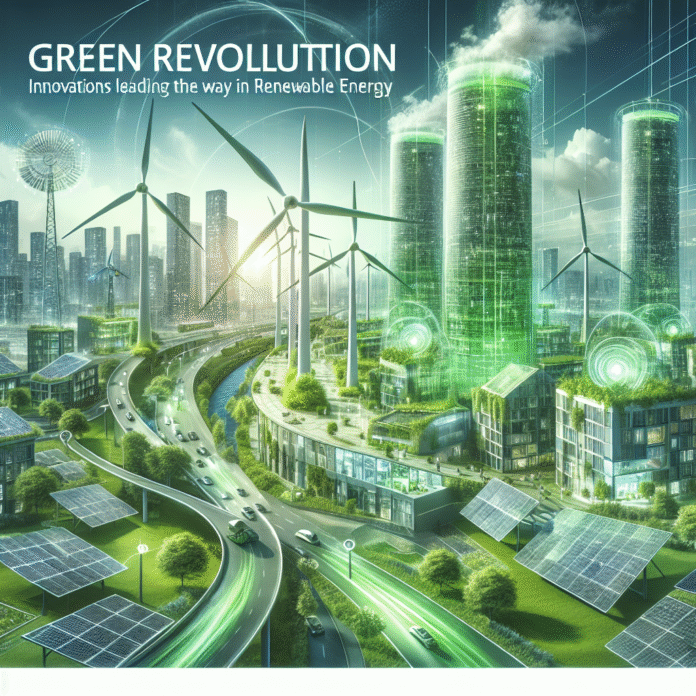The Green Revolution, a term historically tied to significant agricultural advancements, has taken on a new meaning in the 21st century. Today, it represents a worldwide shift towards sustainable energy practices, driven by innovations in renewable technologies. As the climate crisis intensifies, the urgency for clean energy solutions has never been more pressing. This article delves into key innovations leading the way in renewable energy, highlighting their significance and impact on a sustainable future.
1. Solar Power Innovations
Solar energy has undergone rapid advancements, making it one of the most accessible renewable energy sources. The development of perovskite solar cells is a groundbreaking innovation that promises higher efficiency at a lower production cost compared to traditional silicon-based cells. Researchers have made strides in improving stability and longevity, paving the way for widespread adoption.
Bifacial solar panels, which capture sunlight from both sides, are also gaining traction, increasing energy production. With the integration of smart solar inverters, systems can optimize energy usage and enhance grid support, maximizing the benefits of solar energy in everyday applications.
2. Wind Energy Technology
Wind energy continues to be a significant player in the race for renewable resources. The innovation of taller wind turbines allows for capturing wind at higher altitudes, leading to increased efficiency. The deployment of floating wind farms opens up new areas for harnessing wind power, especially in deep-sea locations where wind speeds are more consistent, thereby maximizing energy generation.
Additionally, advancements in energy storage systems specific to wind energy are crucial. By developing better batteries and other storage solutions, energy captured during peak wind conditions can be stored and utilized when demand is highest.
3. Bioenergy Advances
Bioenergy, derived from organic materials, offers a versatile renewable energy solution. Innovations in biogas production from agricultural waste and sewage treatment processes are paving the way for cleaner energy sources. Anaerobic digestion is becoming increasingly efficient, turning waste into valuable energy.
Furthermore, advancements in algal biofuels show promise for a sustainable alternative to fossil fuels. Algae can be cultivated on non-arable land and can consume CO2 during growth, making it a dual solution for energy and carbon reduction.
4. Geothermal Energy
Geothermal energy harnesses heat from beneath the Earth’s surface. Recent technological advancements in enhanced geothermal systems (EGS) have the potential to expand geothermal energy’s geographic reach. By artificially improving permeability in hot rock formations, these systems can produce energy in areas previously thought unsuitable for geothermal exploitation.
The incorporation of heat pumps has also revolutionized how geothermal energy can be used for heating in residential and commercial buildings, drastically reducing energy consumption and emissions.
5. Hydropower Innovations
While traditional hydropower has faced criticism for its environmental impact, innovations in small-scale and micro-hydropower systems are making this resource more sustainable. These systems can be implemented in rivers without large dams, minimizing ecological disruption while providing clean energy to local communities.
Hydrokinetic turbines, which generate power from water currents without the need for dams, also represent a leap forward in harnessing water energy more responsibly.
6. Energy Storage Solutions
A crucial aspect of integrating renewable energy into the grid is efficient energy storage. Battery technology has advanced significantly, with innovations in lithium-sulfur and solid-state batteries promising higher capacities and lower costs. These technologies can store excess energy generated during peak production times, ensuring a steady power supply even when renewable resources are not generating energy.
7. Smart Grid Technologies
The transition to renewable energy is closely linked to smart grid technologies. These systems enhance the efficiency, reliability, and sustainability of electricity distribution. By using AI and machine learning, smart grids can adapt to changing energy demands and integrate various renewable sources seamlessly.
Demand-response systems incentivize consumers to use energy during off-peak times, reducing strain on the grid and enhancing overall efficiency.
Conclusion
The Green Revolution in renewable energy marks a transformative shift toward sustainable practices that are essential for combating climate change. Innovations in solar, wind, bioenergy, geothermal, and hydropower, combined with advances in energy storage and smart grid technologies, are paving the way for a cleaner, more efficient future.
As these technologies evolve, collaboration among governments, industries, and communities will be vital to accelerate their adoption and integration. The journey toward a sustainable energy landscape requires commitment and innovation, but the potential benefits for our planet and future generations make it a pursuit worth undertaking.






